check engine light FIAT DOBLO 2008 1.G User Guide
[x] Cancel search | Manufacturer: FIAT, Model Year: 2008, Model line: DOBLO, Model: FIAT DOBLO 2008 1.GPages: 222, PDF Size: 3.39 MB
Page 111 of 222
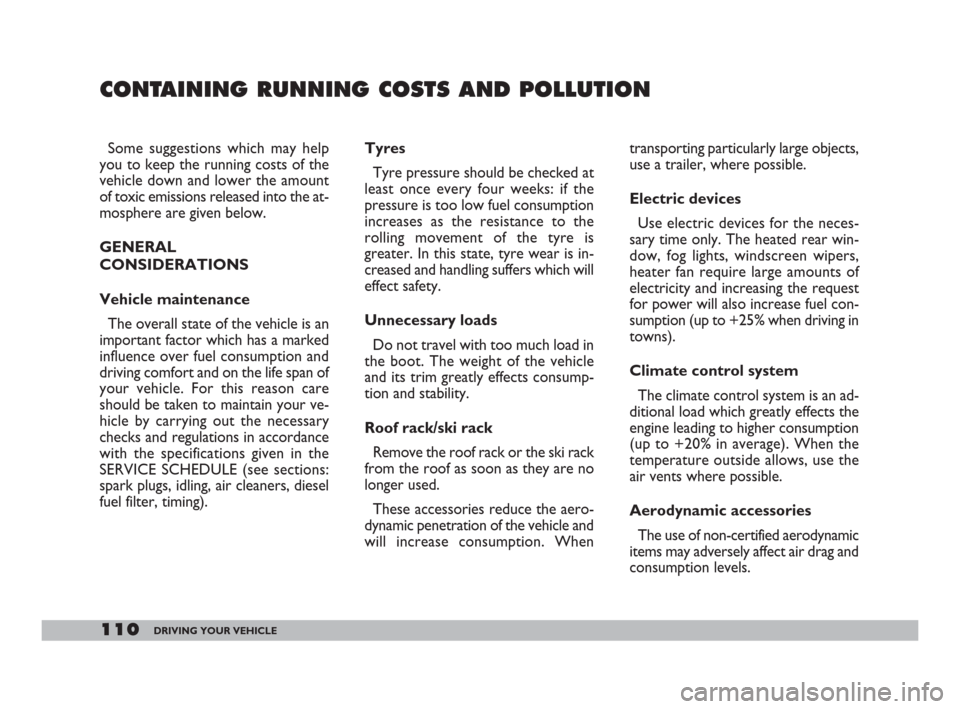
110DRIVING YOUR VEHICLE
Some suggestions which may help
you to keep the running costs of the
vehicle down and lower the amount
of toxic emissions released into the at-
mosphere are given below.
GENERAL
CONSIDERATIONS
Vehicle maintenance
The overall state of the vehicle is an
important factor which has a marked
influence over fuel consumption and
driving comfort and on the life span of
your vehicle. For this reason care
should be taken to maintain your ve-
hicle by carrying out the necessary
checks and regulations in accordance
with the specifications given in the
SERVICE SCHEDULE (see sections:
spark plugs, idling, air cleaners, diesel
fuel filter, timing).Tyres
Tyre pressure should be checked at
least once every four weeks: if the
pressure is too low fuel consumption
increases as the resistance to the
rolling movement of the tyre is
greater. In this state, tyre wear is in-
creased and handling suffers which will
effect safety.
Unnecessary loads
Do not travel with too much load in
the boot. The weight of the vehicle
and its trim greatly effects consump-
tion and stability.
Roof rack/ski rack
Remove the roof rack or the ski rack
from the roof as soon as they are no
longer used.
These accessories reduce the aero-
dynamic penetration of the vehicle and
will increase consumption. Whentransporting particularly large objects,
use a trailer, where possible.
Electric devices
Use electric devices for the neces-
sary time only. The heated rear win-
dow, fog lights, windscreen wipers,
heater fan require large amounts of
electricity and increasing the request
for power will also increase fuel con-
sumption (up to +25% when driving in
towns).
Climate control system
The climate control system is an ad-
ditional load which greatly effects the
engine leading to higher consumption
(up to +20% in average). When the
temperature outside allows, use the
air vents where possible.
Aerodynamic accessories
The use of non-certified aerodynamic
items may adversely affect air drag and
consumption levels.
CONTAINING RUNNING COSTS AND POLLUTION
106-118 Doblo GB 9-05-2008 12:09 Pagina 110
Page 119 of 222
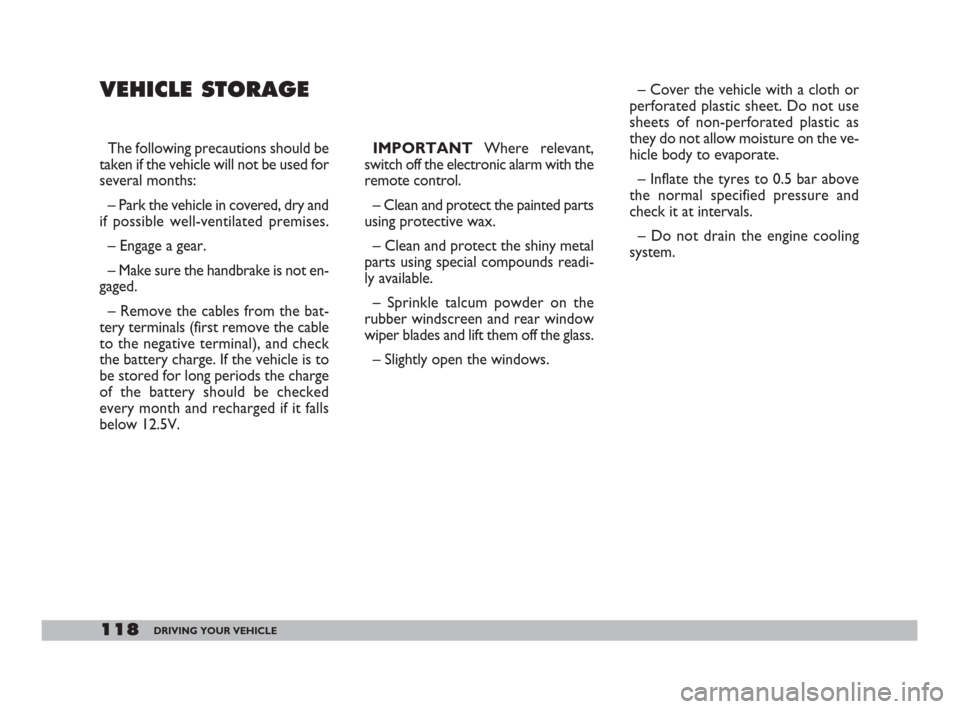
118DRIVING YOUR VEHICLE
The following precautions should be
taken if the vehicle will not be used for
several months:
– Park the vehicle in covered, dry and
if possible well-ventilated premises.
– Engage a gear.
– Make sure the handbrake is not en-
gaged.
– Remove the cables from the bat-
tery terminals (first remove the cable
to the negative terminal), and check
the battery charge. If the vehicle is to
be stored for long periods the charge
of the battery should be checked
every month and recharged if it falls
below 12.5V.IMPORTANT Where relevant,
switch off the electronic alarm with the
remote control.
– Clean and protect the painted parts
using protective wax.
– Clean and protect the shiny metal
parts using special compounds readi-
ly available.
– Sprinkle talcum powder on the
rubber windscreen and rear window
wiper blades and lift them off the glass.
– Slightly open the windows.– Cover the vehicle with a cloth or
perforated plastic sheet. Do not use
sheets of non-perforated plastic as
they do not allow moisture on the ve-
hicle body to evaporate.
– Inflate the tyres to 0.5 bar above
the normal specified pressure and
check it at intervals.
– Do not drain the engine cooling
system.
VEHICLE STORAGE
106-118 Doblo GB 9-05-2008 12:09 Pagina 118
Page 152 of 222
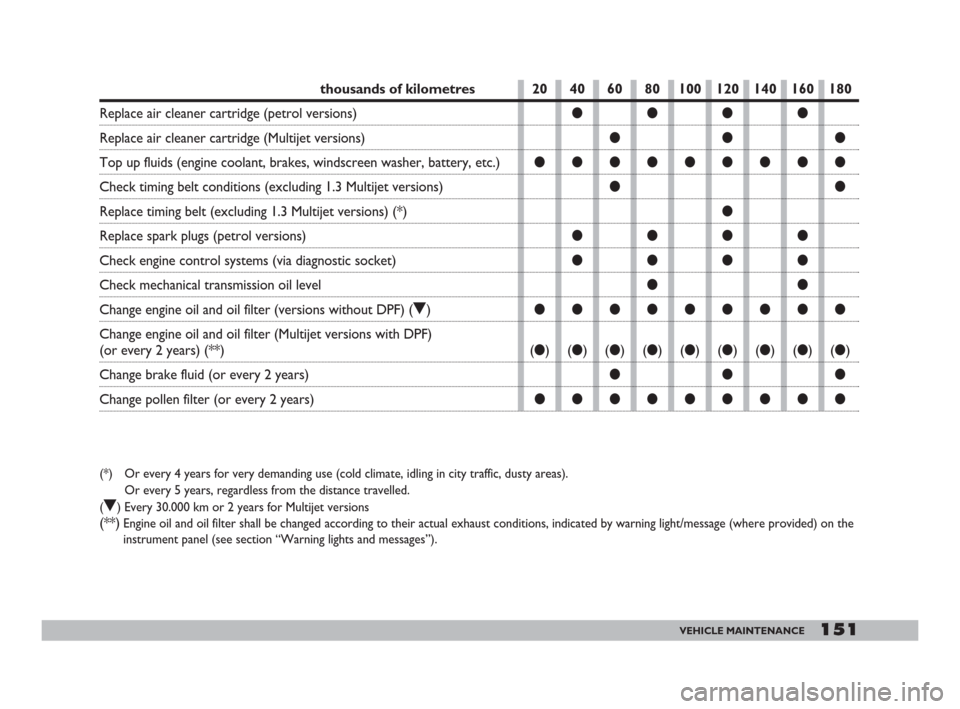
151VEHICLE MAINTENANCE
20 40 60 80 100 120 140 160 180
●●●●
●●●
●●●●●●●●●
●●
●
●●●●
●●●●
●●
●●●●●●●●●
(●)(●)(●)(●)(●)(●)(●)(●)(●)
●●●
●●●●●●●●●thousands of kilometres
Replace air cleaner cartridge (petrol versions)
Replace air cleaner cartridge (Multijet versions)
Top up fluids (engine coolant, brakes, windscreen washer, battery, etc.)
Check timing belt conditions (excluding 1.3 Multijet versions)
Replace timing belt (excluding 1.3 Multijet versions) (*)
Replace spark plugs (petrol versions)
Check engine control systems (via diagnostic socket)
Check mechanical transmission oil level
Change engine oil and oil filter (versions without DPF) (O)
Change engine oil and oil filter (Multijet versions with DPF)
(or every 2 years) (**)
Change brake fluid (or every 2 years)
Change pollen filter (or every 2 years)
(*) Or every 4 years for very demanding use (cold climate, idling in city traffic, dusty areas).
Or every 5 years, regardless from the distance travelled.
(
O) Every 30.000 km or 2 years for Multijet versions
(**)Engine oil and oil filter shall be changed according to their actual exhaust conditions, indicated by warning light/message (where provided) on the
instrument panel (see section “Warning lights and messages”).
149-173 Doblo GB 9-05-2008 12:10 Pagina 151
Page 153 of 222
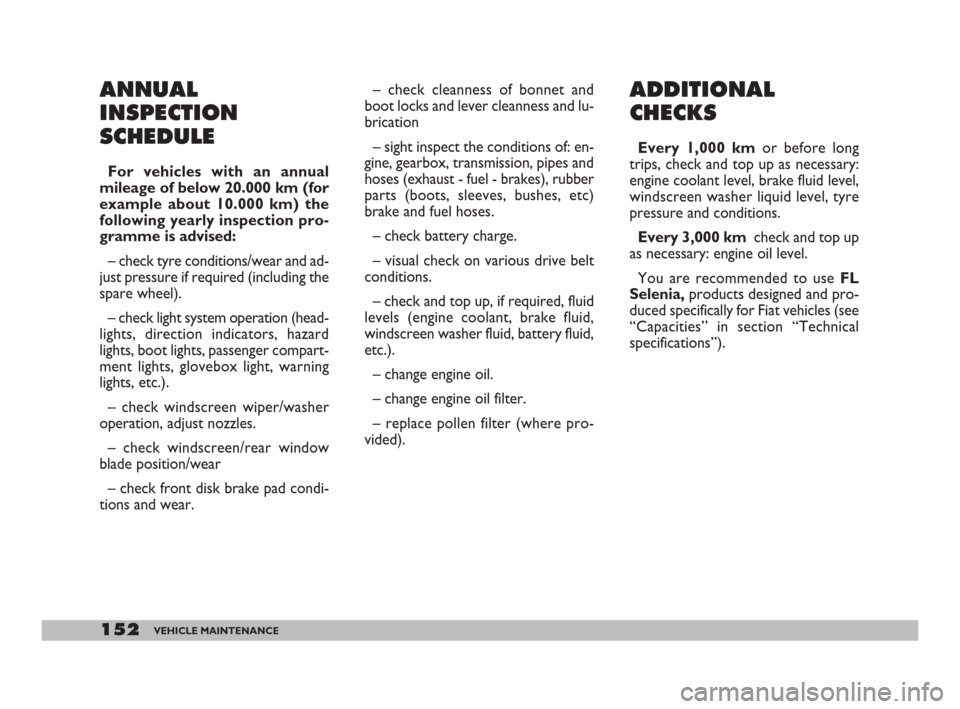
152VEHICLE MAINTENANCE
ANNUAL
INSPECTION
SCHEDULE
For vehicles with an annual
mileage of below 20.000 km (for
example about 10.000 km) the
following yearly inspection pro-
gramme is advised:
– check tyre conditions/wear and ad-
just pressure if required (including the
spare wheel).
– check light system operation (head-
lights, direction indicators, hazard
lights, boot lights, passenger compart-
ment lights, glovebox light, warning
lights, etc.).
– check windscreen wiper/washer
operation, adjust nozzles.
– check windscreen/rear window
blade position/wear
– check front disk brake pad condi-
tions and wear.– check cleanness of bonnet and
boot locks and lever cleanness and lu-
brication
– sight inspect the conditions of: en-
gine, gearbox, transmission, pipes and
hoses (exhaust - fuel - brakes), rubber
parts (boots, sleeves, bushes, etc)
brake and fuel hoses.
– check battery charge.
– visual check on various drive belt
conditions.
– check and top up, if required, fluid
levels (engine coolant, brake fluid,
windscreen washer fluid, battery fluid,
etc.).
– change engine oil.
– change engine oil filter.
– replace pollen filter (where pro-
vided).
ADDITIONAL
CHECKS
Every 1,000 kmor before long
trips, check and top up as necessary:
engine coolant level, brake fluid level,
windscreen washer liquid level, tyre
pressure and conditions.
Every 3,000 km check and top up
as necessary: engine oil level.
You are recommended to use FL
Selenia,products designed and pro-
duced specifically for Fiat vehicles (see
“Capacities” in section “Technical
specifications”).
149-173 Doblo GB 9-05-2008 12:10 Pagina 152
Page 166 of 222
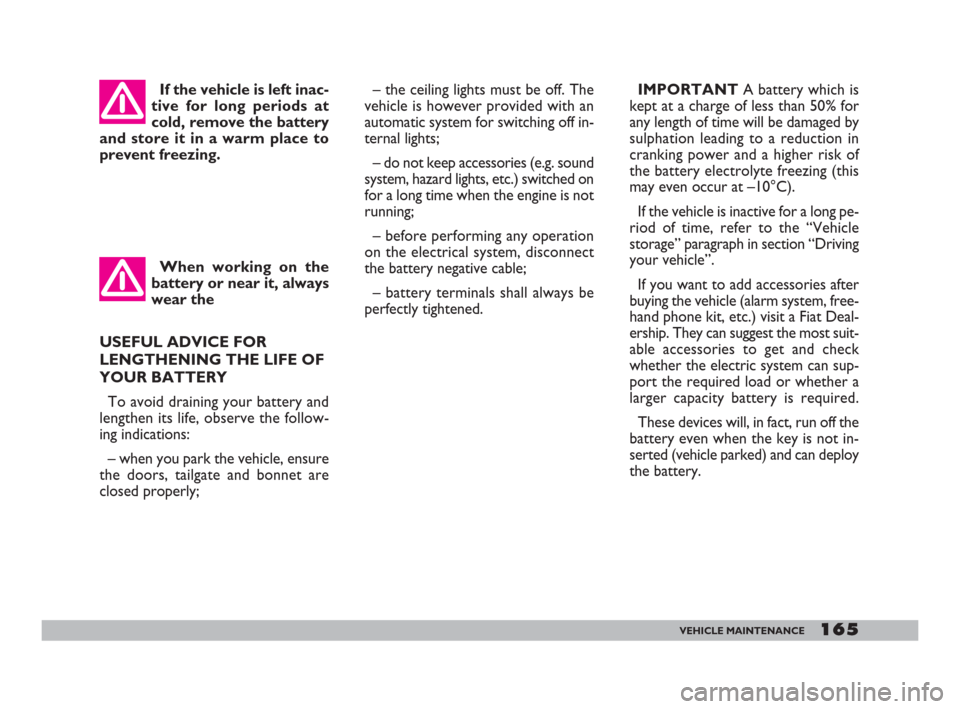
When working on the
battery or near it, always
wear the
USEFUL ADVICE FOR
LENGTHENING THE LIFE OF
YOUR BATTERY
To avoid draining your battery and
lengthen its life, observe the follow-
ing indications:
– when you park the vehicle, ensure
the doors, tailgate and bonnet are
closed properly;If the vehicle is left inac-
tive for long periods at
cold, remove the battery
and store it in a warm place to
prevent freezing.
165VEHICLE MAINTENANCE
IMPORTANTA battery which is
kept at a charge of less than 50% for
any length of time will be damaged by
sulphation leading to a reduction in
cranking power and a higher risk of
the battery electrolyte freezing (this
may even occur at –10°C).
If the vehicle is inactive for a long pe-
riod of time, refer to the “Vehicle
storage” paragraph in section “Driving
your vehicle”.
If you want to add accessories after
buying the vehicle (alarm system, free-
hand phone kit, etc.) visit a Fiat Deal-
ership. They can suggest the most suit-
able accessories to get and check
whether the electric system can sup-
port the required load or whether a
larger capacity battery is required.
These devices will, in fact, run off the
battery even when the key is not in-
serted (vehicle parked) and can deploy
the battery. – the ceiling lights must be off. The
vehicle is however provided with an
automatic system for switching off in-
ternal lights;
– do not keep accessories (e.g. sound
system, hazard lights, etc.) switched on
for a long time when the engine is not
running;
– before performing any operation
on the electrical system, disconnect
the battery negative cable;
– battery terminals shall always be
perfectly tightened.
149-173 Doblo GB 9-05-2008 12:10 Pagina 165
Page 206 of 222
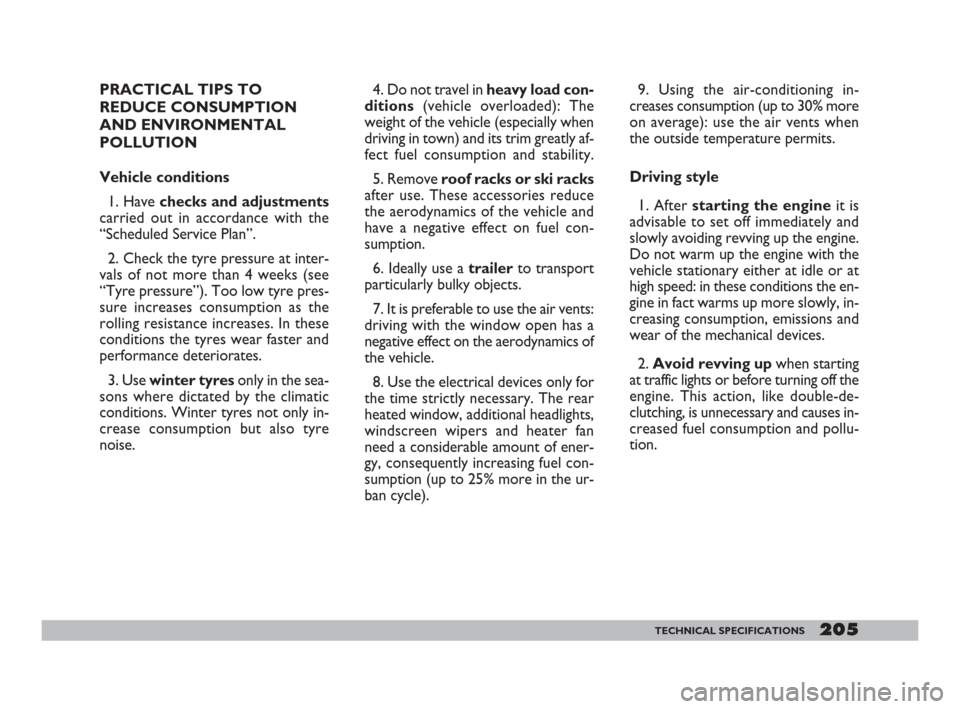
205TECHNICAL SPECIFICATIONS205
PRACTICAL TIPS TO
REDUCE CONSUMPTION
AND ENVIRONMENTAL
POLLUTION
Vehicle conditions
1. Have checks and adjustments
carried out in accordance with the
“Scheduled Service Plan”.
2. Check the tyre pressure at inter-
vals of not more than 4 weeks (see
“Tyre pressure”). Too low tyre pres-
sure increases consumption as the
rolling resistance increases. In these
conditions the tyres wear faster and
performance deteriorates.
3. Use winter tyresonly in the sea-
sons where dictated by the climatic
conditions. Winter tyres not only in-
crease consumption but also tyre
noise.4. Do not travel in heavy load con-
ditions(vehicle overloaded): The
weight of the vehicle (especially when
driving in town) and its trim greatly af-
fect fuel consumption and stability.
5. Remove roof racks or ski racks
after use. These accessories reduce
the aerodynamics of the vehicle and
have a negative effect on fuel con-
sumption.
6. Ideally use a trailerto transport
particularly bulky objects.
7. It is preferable to use the air vents:
driving with the window open has a
negative effect on the aerodynamics of
the vehicle.
8. Use the electrical devices only for
the time strictly necessary. The rear
heated window, additional headlights,
windscreen wipers and heater fan
need a considerable amount of ener-
gy, consequently increasing fuel con-
sumption (up to 25% more in the ur-
ban cycle).9. Using the air-conditioning in-
creases consumption (up to 30% more
on average): use the air vents when
the outside temperature permits.
Driving style
1. After starting the engineit is
advisable to set off immediately and
slowly avoiding revving up the engine.
Do not warm up the engine with the
vehicle stationary either at idle or at
high speed: in these conditions the en-
gine in fact warms up more slowly, in-
creasing consumption, emissions and
wear of the mechanical devices.
2. Avoid revving upwhen starting
at traffic lights or before turning off the
engine. This action, like double-de-
clutching, is unnecessary and causes in-
creased fuel consumption and pollu-
tion.
174-211 Doblo GB 16-12-2008 14:26 Pagina 205
Page 214 of 222
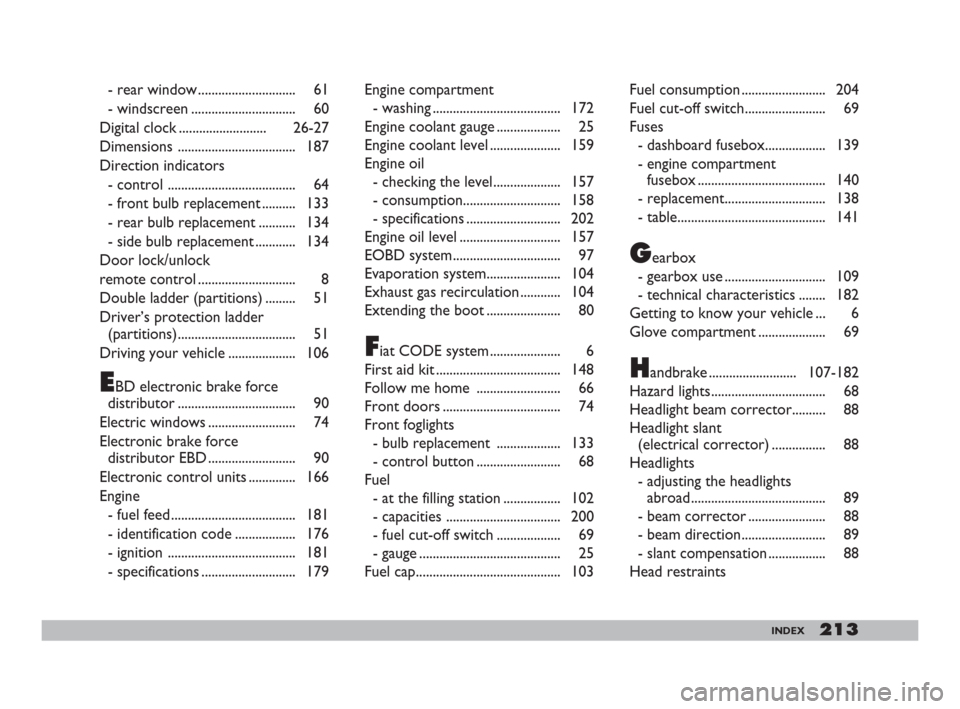
213INDEX
- rear window ............................. 61
- windscreen ............................... 60
Digital clock .......................... 26-27
Dimensions ................................... 187
Direction indicators
- control ...................................... 64
- front bulb replacement .......... 133
- rear bulb replacement ........... 134
- side bulb replacement ............ 134
Door lock/unlock
remote control ............................. 8
Double ladder (partitions) ......... 51
Driver’s protection ladder
(partitions)................................... 51
Driving your vehicle .................... 106
EBD electronic brake force
distributor ................................... 90
Electric windows .......................... 74
Electronic brake force
distributor EBD .......................... 90
Electronic control units .............. 166
Engine
- fuel feed ..................................... 181
- identification code .................. 176
- ignition ...................................... 181
- specifications ............................ 179Engine compartment
- washing ...................................... 172
Engine coolant gauge ................... 25
Engine coolant level ..................... 159
Engine oil
- checking the level.................... 157
- consumption............................. 158
- specifications ............................ 202
Engine oil level .............................. 157
EOBD system................................ 97
Evaporation system...................... 104
Exhaust gas recirculation ............ 104
Extending the boot ...................... 80
Fiat CODE system ..................... 6
First aid kit ..................................... 148
Follow me home ......................... 66
Front doors ................................... 74
Front foglights
- bulb replacement ................... 133
- control button ......................... 68
Fuel
- at the filling station ................. 102
- capacities .................................. 200
- fuel cut-off switch ................... 69
- gauge .......................................... 25
Fuel cap........................................... 103Fuel consumption ......................... 204
Fuel cut-off switch........................ 69
Fuses
- dashboard fusebox.................. 139
- engine compartment
fusebox ...................................... 140
- replacement.............................. 138
- table............................................ 141
Gearbox
- gearbox use .............................. 109
- technical characteristics ........ 182
Getting to know your vehicle ... 6
Glove compartment .................... 69
Handbrake .......................... 107-182
Hazard lights.................................. 68
Headlight beam corrector.......... 88
Headlight slant
(electrical corrector) ................ 88
Headlights
- adjusting the headlights
abroad........................................ 89
- beam corrector ....................... 88
- beam direction......................... 89
- slant compensation ................. 88
Head restraints
212-220 Doblo GB 16-12-2008 14:26 Pagina 213